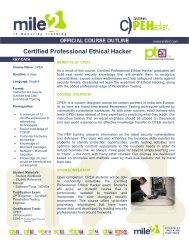Certified Penetration Testing Engineer - Mile2
Certified Penetration Testing Engineer - Mile2
Certified Penetration Testing Engineer - Mile2
You also want an ePaper? Increase the reach of your titles
YUMPU automatically turns print PDFs into web optimized ePapers that Google loves.
8.37 Windows Rootkit Countermeasures<br />
8.38 Review<br />
8.39 Lab 8 – Hacking Windows<br />
8.39.1 Exercise 1 – Cracking a Windows Password<br />
with Linux<br />
8.39.2 Exercise 2 – Cracking a Windows Password<br />
with Cain and Abel<br />
8.39.3 Exercise 3 – Covering your tracks<br />
8.39.4 Exercise 4 – Alternate Data Streams<br />
8.39.5 Exercise 5 – Steganography<br />
8.39.6 Exercise 6 – Understanding Rootkits<br />
8.39.7 Exercise 7 – Turn in your Documentation<br />
Module 9 – Hacking UNIX/Linux<br />
9.1 Overview<br />
9.2 Introduction<br />
9.3 Linux Introduction<br />
9.4 File System Structure<br />
9.5 Kernel<br />
9.6 Processes<br />
9.7 Starting and Stopping Processes<br />
9.8 Interacting with Processes<br />
9.9 Accounts and Groups<br />
9.10 Password and Shadow File Formats<br />
9.11 More on Accounts and Groups<br />
9.12 Linux and UNIX Permissions<br />
9.13 Set UID Programs<br />
9.14 Trust Relationships<br />
9.15 Logs and Auditing<br />
9.16 Common Network Services<br />
9.17 Remote Access Attacks<br />
9.18 Brute-Force Attacks<br />
9.19 Brute-Force Countermeasures<br />
9.20 X Window System<br />
9.21 X Insecurities Countermeasures<br />
9.22 Network File System<br />
9.23 NFS in Action<br />
9.24 NFS Countermeasure<br />
9.25 Passwords and Encryption<br />
9.26 Password Cracking Tools<br />
9.27 Salting<br />
9.28 Symbolic Link<br />
9.29 Symlink Countermeasure<br />
9.30 Core File Manipulation<br />
9.31 Shared Libraries<br />
9.32 Kernel Flaws<br />
9.33 File and Directory Permissions<br />
9.34 SUID Files Countermeasure<br />
9.35 File and Directory Permissions<br />
9.36 World-Writable Files Countermeasure<br />
9.37 Clearing the Log Files<br />
9.38 Rootkits – User and Kernel<br />
9.39 Rootkit Countermeasure<br />
9.40 Review<br />
9.41 Lab 10 – Hacking UNIX/Linux<br />
9.41.1 Exercise 1 – Setup and Recon<br />
9.41.2 Exercise 2 – Making use of a poorly configured<br />
service.<br />
9.41.3 Exercise 3 – Cracking a Linux Password<br />
9.41.4 Exercise 4 – Creating a simple backdoor and<br />
covering your tracks.<br />
9.41.5 Exercise 5 – Turn in your Documentation<br />
Module 10 – Advanced Exploitation Techniques<br />
10.1 Overview<br />
10.2 How Do Exploits Work?<br />
10.3 Format String<br />
10.4 Race Conditions<br />
10.5 Memory Organization<br />
10.6 Buffer Overflows<br />
10.7 Buffer Overflow Illustration<br />
10.8 How Stacks Work<br />
10.9 Stack Function Illustrated<br />
10.10 Buffer Overflow Illustration #2<br />
10.11 Heap Overflows<br />
10.12 Heap Spraying<br />
10.13 Prevention<br />
10.14 Secure Code Reviews<br />
10.15 Review Process<br />
10.16 Know the Vulnerabilities<br />
10.17 Know the Business Risks<br />
10.18 When to Conduct the Review<br />
10.19 Who should be Involved<br />
10.20 What to Look For<br />
10.21 Fixing the Issues<br />
10.22 Automated Tools<br />
10.23 Stages of Exploit Development<br />
10.24 Shellcode Development<br />
10.25 Metasploit<br />
10.26 Metasploit - Mete<br />
10.27 Fuzzers<br />
10.28 SaintExploit<br />
10.29 Core Impact<br />
10.30 Tools Comparison<br />
10.31 Review<br />
10.32 Lab 10 – Advanced Exploitation Techniques<br />
10.32.1 Exercise 1 – Metasploit Command Line<br />
10.32.2 Exercise 2 – Metasploit Web Interface<br />
10.32.3 Exercise 3 – Milw0rm<br />
10.32.4 Exercise 4 – SaintExploit<br />
10.32.5 Exercise 5 – Core Impact<br />
10.32.6 Exercise 6 – Turn in your Documentation<br />
Module 11 – Pen <strong>Testing</strong> Wireless Networks<br />
11.1 Overview<br />
11.2 Standards Comparison<br />
6



